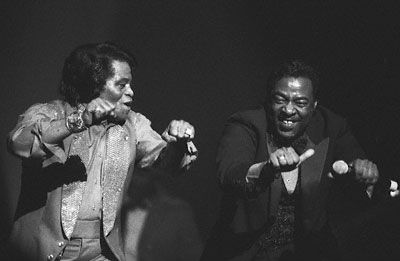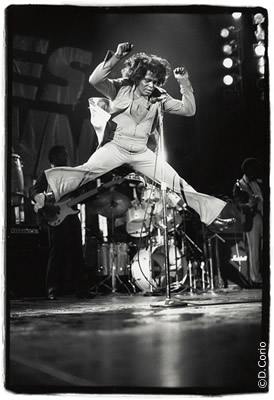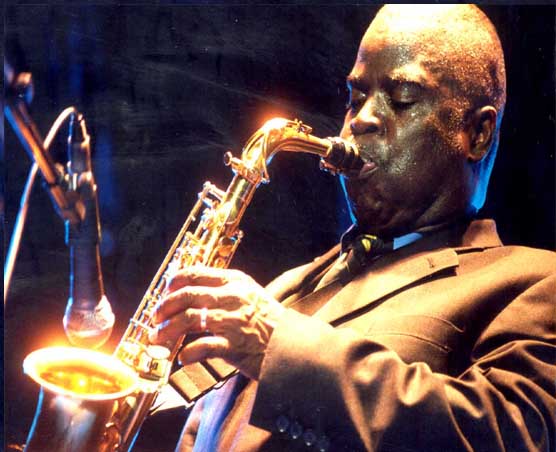JAMES BROWN & BOBBY BYRD / “Since You Been Gone”
Jammeeeesssssszzzzz BROWN!
 "Since You Been Gone" is from Motherlode, a relatively under-appreciated release. The track features Bobby Byrd dueting/dueling with J.B. I’m pretty sure that’s Bootsy on bass. I consider this a classic because it illustrates James Brown pulling together a funk song out of a chant, a phrase, and nothing but an unquenchable desire to make everything he do be funky.
Mr. Brown is the pinnacle, the absolute founder, the chief exponent, and the unmatched creator of funk. When it comes to funk, nobody—did you hear me?—not nobody in the whole wide world has ever done what this man has done. And check this, nor have any of the band members or alumni ever been able to put together records as funky as Mr. Brown. It's not just the components, it's the conductor.
"Since You Been Gone" is from Motherlode, a relatively under-appreciated release. The track features Bobby Byrd dueting/dueling with J.B. I’m pretty sure that’s Bootsy on bass. I consider this a classic because it illustrates James Brown pulling together a funk song out of a chant, a phrase, and nothing but an unquenchable desire to make everything he do be funky.
Mr. Brown is the pinnacle, the absolute founder, the chief exponent, and the unmatched creator of funk. When it comes to funk, nobody—did you hear me?—not nobody in the whole wide world has ever done what this man has done. And check this, nor have any of the band members or alumni ever been able to put together records as funky as Mr. Brown. It's not just the components, it's the conductor.
 James Brown's secret ingredient was that he was a supreme dancer and therefore understood how rhythms work the body. J.B. directed his band by dancing and singing like he was a drum. Don’t worry about the key, get the feeling. The feeling is the key; the key of phunk. Scream if you wanna, but don’t drop the beat. Count on your feet to keep the feeling. Not saying other people can’t dance, just that a bandleader who does dance has a significantly better chance at getting the band to get down than one who doesn’t; Prince comes immediately to mind in this regard. And by dance, I’m talking body movement. There are some who come to mind who did not formally cut dance steps, but their body movements instructed the flow and how they wanted the music to go. Think Ray Charles and Stevie Wonder. In any case, to truly understand the funk dead on the one, you’ve got to dig dancing.
James Brown's secret ingredient was that he was a supreme dancer and therefore understood how rhythms work the body. J.B. directed his band by dancing and singing like he was a drum. Don’t worry about the key, get the feeling. The feeling is the key; the key of phunk. Scream if you wanna, but don’t drop the beat. Count on your feet to keep the feeling. Not saying other people can’t dance, just that a bandleader who does dance has a significantly better chance at getting the band to get down than one who doesn’t; Prince comes immediately to mind in this regard. And by dance, I’m talking body movement. There are some who come to mind who did not formally cut dance steps, but their body movements instructed the flow and how they wanted the music to go. Think Ray Charles and Stevie Wonder. In any case, to truly understand the funk dead on the one, you’ve got to dig dancing.
 On another note, we’re including “Funk Bomb,” also from Motherlode. This instrumental track, which features Maceo Parker on alto, is a reference for the Kenny Garrett tracks that follow. Kenny had one foot knee deep in Maceo’s shit and, to my ears, even raised the odorifous level a couple of notches. But listen first to Maceo, so you can know where the funk side of Kenny originates.
—Kalamu ya Salaam
The Thing
Yeah, J.B. is the man, of course. He was, is, and will always remain the one and only Minister Of The New Super Super Heavy Funk. (You gotta get both 'supers' in there or it's just not right.) When it comes to the Motherlode LP, I'm kinda partial to "People Get Up And Drive Your Funky Soul," but that's just me. The track I actually want to hip y'all to predates J.B.'s 'Super Heavy Funk' period by quite a few years. It's a tune named "The Thing In 'G'" and it's taken from the Minister's 1963 LP Prisoner Of Love. Since we're mixing jazz and funk in this week's jukebox, I thought this would be a perfect time to drop "The Thing," which, as J.B. sort of explains in the intro, is a jazz-funk hybrid.
Actually, you know what? I was going to pick out a line or two of J.B.'s monologue, but the spoken introduction is so classic that I'll just lay the whole thing on you. I've been listening to it over and over, trying to figure out why it's so funny. I haven't come up with anything cogent to say about it yet except that I was laughing before J.B. got through the first line where he explains to the listeners that the voice talking is, in fact, James Brown. I mean, dude probably has the most distinct speaking voice in the history of speaking voices and he's going, "I want to start by saying, this is James Brown." The apologetic tone he uses when he starts talking about trying to play jazz is pretty funny too. Hell, all of it is funny. Until the beat drops. It's the Minister, people. Check it out:
On another note, we’re including “Funk Bomb,” also from Motherlode. This instrumental track, which features Maceo Parker on alto, is a reference for the Kenny Garrett tracks that follow. Kenny had one foot knee deep in Maceo’s shit and, to my ears, even raised the odorifous level a couple of notches. But listen first to Maceo, so you can know where the funk side of Kenny originates.
—Kalamu ya Salaam
The Thing
Yeah, J.B. is the man, of course. He was, is, and will always remain the one and only Minister Of The New Super Super Heavy Funk. (You gotta get both 'supers' in there or it's just not right.) When it comes to the Motherlode LP, I'm kinda partial to "People Get Up And Drive Your Funky Soul," but that's just me. The track I actually want to hip y'all to predates J.B.'s 'Super Heavy Funk' period by quite a few years. It's a tune named "The Thing In 'G'" and it's taken from the Minister's 1963 LP Prisoner Of Love. Since we're mixing jazz and funk in this week's jukebox, I thought this would be a perfect time to drop "The Thing," which, as J.B. sort of explains in the intro, is a jazz-funk hybrid.
Actually, you know what? I was going to pick out a line or two of J.B.'s monologue, but the spoken introduction is so classic that I'll just lay the whole thing on you. I've been listening to it over and over, trying to figure out why it's so funny. I haven't come up with anything cogent to say about it yet except that I was laughing before J.B. got through the first line where he explains to the listeners that the voice talking is, in fact, James Brown. I mean, dude probably has the most distinct speaking voice in the history of speaking voices and he's going, "I want to start by saying, this is James Brown." The apologetic tone he uses when he starts talking about trying to play jazz is pretty funny too. Hell, all of it is funny. Until the beat drops. It's the Minister, people. Check it out:
Ladies and gentleman, I want to start by saying, this is James Brown. And, uh, this is kind of a new thing. I'm not going to be formal. [Deep breath.] I'm going to be real down to earth and soulful. [Pause.] See, I've never cut a jazz tune before. And the fellas—the same band that cut "Think" and "Try Me" and all the other things—we're going to cut this thing. [Pause.] We call it "The Thing In 'G'." Because, you see, we're not jazz cats. We're just starting, so we'll start by kicking it off. [Sound of a foot, J.B.'s presumably, tapping out the groove.]—Mtume ya Salaam There was a time There was a time when instrumental popular music was not considered jazz. Neither the public nor the musicians (hence J.B.'s intro) confused the two even though they obviously had elements in common. I won't try to explain all of the differences, but I think if folk listen closely to "The Thing In 'G'" and "Funk Bomb," they will hear some of the distinctions for themselves. There is, however, one difference I will point out: the narrative line of the featured solo. To put it simply, when a soloist plays short phrases that emphasize the heavy backbeat, regardless of the context, they are playing in a funk style rather than a jazz style. If you listen to the Kenny Garrett solos included in this week's jukebox, you will hear that he is mostly playing in a funk mode, a mode whose contemporary leader is Maceo Parker. Maceo is a master of the funk solo. Although the tenor saxophone is associated with honking and screaming in R&B, it's noteworthy that Maceo is the most recognizable and undoubtedly most respected funk instrumental soloist. Moreover, Maceo is doing it on the alto saxophone. I think of Maceo as the resurrection and further purification of Louis Jordan. Although that succession means nothing to most funk fans, to those who want to grasp both the significance as well as the history of funk, it is important to understand that, one way or another, to a greater or lesser extent, everything that "is" today grows out of what "was" yesterday. Or as our African ancestors said: know the beginning well and the end will not trouble you. Besides Louis Jordan two other important alto players comprising the roots of the funk alto are Eddie 'Cleanhead' Vinson and Earl Bostic (who influenced John Coltrane). Although we don't have room this week to put all these cats' music in the jukebox, I do want to acknowledge them, and for sure in the months ahead we will feature some of their work. All of which is to say that Kenny Garrett in particular is a synthesis of all of the above in his funk-ability. —Kalamu ya Salaam
This entry was posted on Saturday, April 15th, 2006 at 11:54 pm and is filed under Classic. You can follow any responses to this entry through the RSS 2.0 feed. You can leave a response, or trackback from your own site.
3 Responses to “JAMES BROWN & BOBBY BYRD / “Since You Been Gone””
April 17th, 2006 at 9:24 am
What can you say…about the Godfather of Soul (a title I like better than Minister of The New Super-Heavy Funk, but that is another story). Whether the Flames or the JB’s, James Brown was indeed a conductor. Though, I’d love to see him in front of the Boston Pops or some Orchestra (could Mozart be funky?)
Anyways, James Brown’s success was not only the result of his ‘conducting’, but also in part by visionary musicians. There are many, however Bootsy and Maceo are the quickest to come to mind though. John “Jabo” Starks, Clyde Stubblefield, Melvin Parker, St. Clair Pinckney, Fred Wesley, and Alphonso Kellum also deserve some credit.
Thanks for “The Thing In G”! As a “Jazz” piece I like Funk Bomb a little better though. It’s dancable. Come to think of it, I can imagine James Brown dancing to “The Think In G”, especially in the continuity breaks.
April 18th, 2006 at 2:11 pm
James Brown never ceases tuh amaze me. I’m just humbled to know that I’m alive at the same time as the bruhthuh who gets ya movin whethuh ya wanna or not.
April 22nd, 2006 at 3:56 am
I was lucky enough to get payed mad money to work a JB show about 10 years ago… with Sugar Hill Gang opening no less. Thanks for turning me on to some JB I haven’t heard!
Leave a Reply
| top |